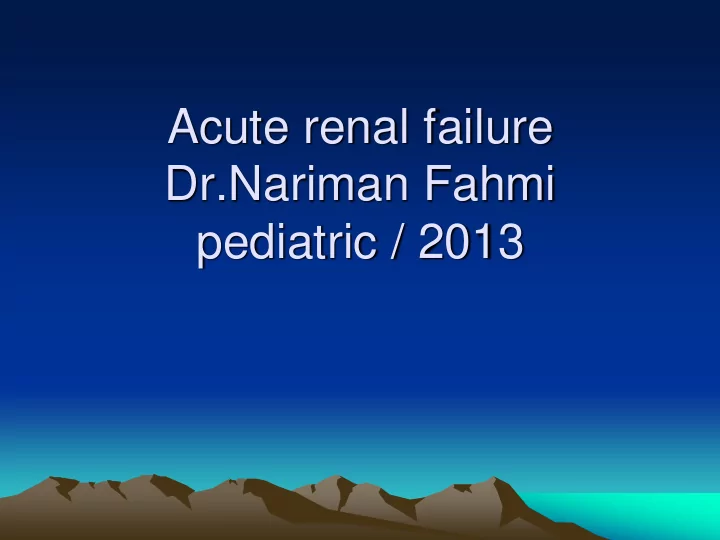

Acute renal failure Dr.Nariman Fahmi pediatric / 2013
Objectives • Introduction • Defintion • Classification • management
To function properly kidneys require: • Normal renal blood flow • Functioning glomeruli and tubules • Clear urinary outflow tract – for drainage and elimination of formed urine from the body.
ARF - definition • An abrupt fall in GFR over a period of minutes to days with rapid & sustained rise in nitrogenous waste products in blood. (Rate of production of metabolic waste exceeds the rate of renal excretion)
definition Sudden loss of the ability of the kidneys to excrete wastes, concentrate urine and conserve electrolytes
Definitions • Oligurea • Low urine output • < 300 ml/m2/day • Anurea • No urine output
Causes of AKF • Prerenal : renal hypoperfusion • Renal (Intrinsic) : – Glomerular – Tubular – Vascular injury – Interstitial • Post renal: obstruction
PRE-RENAL ( Hemodynamic ) AKI Hypovolaemia Hypotension Haemorrhage Cardiogenicshock Volume depletion (sepsis, ( vomiting, anaphylaxis) diarrhoea, burns) Renal Hypoperfusion NSAIDs ACEI / ARBs RAS /occlusion Generalized or localized Hepatorenal reduction in RBF syndrome Oedema states Reduced GFR Cardiac failure Hepatic cirrhosis Nephrotic syndrome PRERENAL AKI
Renal / Intrinsic AKI Glomerular Tubular Vascular Interstitial Ac. Interstitial Vascular Ac.GN ATN occlusions nephritis Ischemia post-infectious, - Renal artery Toxins Drug induced - SLE, occlusion NSAIDs, ANCA associated, antibiotics - Renal vein Infiltrative - Henoch-Schönlein thrombosis lymphoma purpura Granulomatous- , tuberculosis Thrombotic Infection related - microangiopathy post-infective, TTP pyelonephritis HUS N Engl J Med 1996;334 (22):1448-60
Post-renal Urinary outflow tract obstruction Intrinsic Extrinsic • Pelvic Intra-luminal Intra-mural • Stone, • Urethral stricture, malignancies • Blood clots, • Bladder tumour, • Retroperitonea • Papillary • Radiation fibrosis l fibrosis necrosis Principal POST-RENAL causes of AKI
Careful history may aid in defining the cause of renal failure S.&S. Oligurea or anuria Fluid retention Ankle ,legs swelling Changes in mental status Drawsiness , lethargy, confuion ,coma Seizures Vomiting hypertension
Factors that suggest chronicity include – Long duration of symptoms, Nocturia, Absence of acute illness, anaemia, hyperphosphatemia, and hypocalcaemia,
On examination : note state of dehydration Is the patient euvolaemic? Pulse, JVP/CVP, blood pressure, Fluid challenge
Has obstruction been excluded? Complete anuria Palpable bladder Renal ultrasound Hilton et al, BMJ 2006;333;786-790
What investigations are most useful in ARF? Urinalysis: Dipstick for blood, protein, or both - Suggests a renal inflammatory process Microscopy for cells, casts, crystals - Red cell casts diagnostic in glomerulonephritis Hilton et al, BMJ 2006;333;786-790
RBCs • Dysmorphic red blood cells suggest glomerular injury.
Granular cast Red blood cell cast Marker of glomerular injury
Biochemistry Serial blood urea, creatinine, electrolytes, Blood gas analysis, serum bicarbonate – Important metabolic consequences of ARF include hyperkalaemia, metabolic acidosis, hypocalcaemia, hyperphosphataemia
• Radiology • Renal ultrasonography – For renal size, symmetry, evidence of obstruction
Treatment The goal is to • 1-identify any reversible causes • 2- preventing excess accumulation of fluids and wastes Hospitalizations is required for treatment and monitoring
• Antibiotics may be used to treat infection • Diuretics may be used to remove fluid Control dangerous hyperkalemia • S.k more than 6 meq/l • 1- calcium gluconate 10% solution • 2-sodium bicarbonate 7.5%solution • 3-Glucose 50 % with insulin1unit/5 g glucose • 4-B receptor agonist • 5-Oral or rectal potassium exchange resine(kayexalate)
• Hyponatremia is most commonly a dilutional disturbance • Nacl (meq/L) required =0.6(BW Kg)x {125- serum sodium (meq/L)} • Nutrition in acute renal failure • sodium, potassium, and phosphorus should be restricted. • Protein intake should be restricted
Hypertension Agent Dose Onset Action Complications Hydralazine 0.2 to 15 mg/dose • Nifedipine 0.25-0.5 mg/kg sublingual • Frusemide 1-3mg/kg over 15min 0.1-1mg/kg/hr Diazoxide 5 mg/kg (max 300) IV bolus 3-5 min
• gastrointestinal bleeding • Neurological symptoms • anemia of ARF is generally mild (hemoglobin 9 – 10 g/dL) and primarily results from volume expansion (hemodilution )
dialysis Used to remove excess waste and fluids Indications 1- uncontrollable fluids overload or hypertension 2- uncontrollable acidosis 3- uncontrollable electrolyte disturbances 4-pericarditis 5- change in mental status 6-anuria 7-uncontrollable accumulations of nitrogen waste products
Thank you
Recommend
More recommend